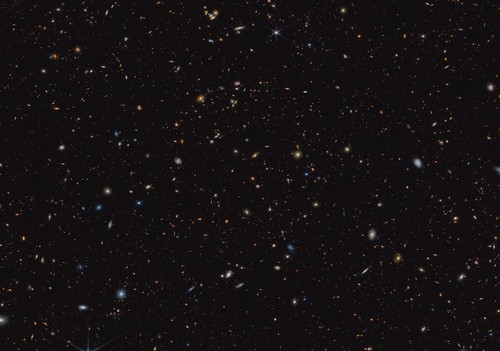The formation of the first stars and galaxies has long been a fundamental question in astronomy. NASA’s James Webb Space Telescope (JWST) is offering new insights into this topic.
One of the key initiatives in the early stages of Webb’s scientific mission is the JWST Advanced Deep Extragalactic Survey (JADES), aimed at studying faint, distant galaxies.
Even with ongoing data collection, JADES has already made remarkable discoveries, including the identification of numerous galaxies that existed when the universe was less than 600 million years old. Notably, these galaxies are teeming with young, hot stars.

Unveiling Star Factories:
Under the leadership of Marcia Rieke from the University of Arizona in Tucson, the JADES program aims to address critical questions about the assembly of early galaxies, the speed of star formation, and the reasons why some galaxies cease forming stars.
By examining galaxies that originated in the first 600 million years of the universe’s existence, the JADES team has unearthed a wealth of ancient galaxies, providing valuable insights into the early universe.
Galaxies Ablaze with Young, Hot Stars:
An important discovery emerging from the JADES program is the observation of galaxies aglow with a multitude of young, hot stars.
Ryan Endsley and colleagues from the University of Texas at Austin focused their study on galaxies that existed 500 to 850 million years after the Big Bang, during a pivotal period called the Epoch of Reionization.
Leveraging Webb’s NIRSpec instrument, they found that nearly every galaxy examined exhibited unusually strong emission line signatures, indicative of intense recent star formation.
These early galaxies demonstrated exceptional proficiency in generating hot, massive stars, which played a significant role in transforming the surrounding gas from opaque to transparent, ultimately contributing to the process of reionization.
Episodic Star Formation:
The research conducted by Endsley and his team also highlighted periods of rapid star formation followed by quieter intervals within these young galaxies. This pattern suggests that the galaxies captured clumps of gaseous material required for star formation and experienced episodic bursts of star production.
An alternative explanation suggests that the explosive deaths of massive stars injected energy into the surrounding environment periodically, inhibiting gas condensation and the formation of new stars. These findings shed light on the intricate nature of star formation in the early universe.
Unveiling the Early Universe:
Another aspect of the JADES program involves the search for the earliest galaxies that existed when the universe was less than 400 million years old. Examining these galaxies provides astronomers with a glimpse into how star formation in the early universe differed from current observations.
Remarkably, JADES has already uncovered nearly a thousand extremely distant galaxies, predating the universe at under 650 million years old. These findings have exceeded expectations, surpassing previous predictions made prior to the launch of the Webb telescope.
Sharper Views of Distant Galaxies:
The cutting-edge instruments on board the James Webb Space Telescope, such as NIRCam, have enabled astronomers to obtain detailed measurements of these far-flung galaxies.
Webb’s exceptional resolution and sensitivity have revealed that these galaxies, once perceived as mere smudges, possess discernible structures and clusters of stars taking shape within a few hundred million years of the universe’s inception. These findings have revolutionized our understanding of star formation during the early stages of the universe.
Conclusion:
The initial data from the JWST Advanced Deep Extragalactic Survey (JADES), conducted using NASA’s James Webb Space Telescope, is already unveiling groundbreaking insights into the formation of the first stars and galaxies. The discovery of galaxies abounding with young, hot stars and the revelation of the complex patterns of star formation in the early universe challenge our previous assumptions. Webb’s unrivaled resolution and sensitivity provide astronomers with an unprecedented view of distant galaxies, unraveling a tapestry of cosmic history. As Webb continues its observations, we eagerly anticipate further revelations about the early universe and our place within it.
